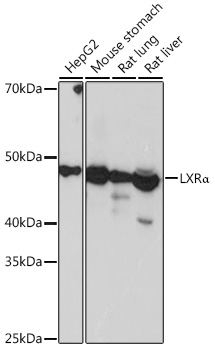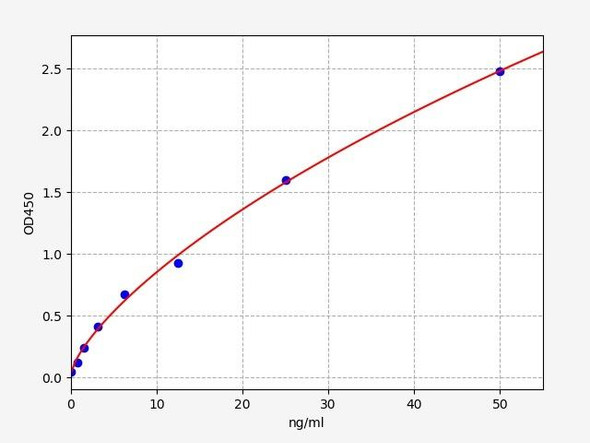Epigenetics & Nuclear Signaling Antibodies 5
Anti-LXRAlpha Antibody (CAB3974)
- SKU:
- CAB3974
- Product Type:
- Antibody
- Reactivity:
- Human
- Reactivity:
- Mouse
- Reactivity:
- Rat
- Host Species:
- Rabbit
- Isotype:
- IgG
- Research Area:
- Epigenetics and Nuclear Signaling
Description
| Antibody Name: | Anti-LXRAlpha Antibody |
| Antibody SKU: | CAB3974 |
| Antibody Size: | 20uL, 50uL, 100uL |
| Application: | WB IHC |
| Reactivity: | Human, Mouse, Rat |
| Host Species: | Rabbit |
| Immunogen: | A synthesized peptide derived from human LXRAlpha |
| Application: | WB IHC |
| Recommended Dilution: | WB 1:500 - 1:2000 IHC 1:50 - 1:200 |
| Reactivity: | Human, Mouse, Rat |
| Positive Samples: | 293T, HepG2, Mouse liver, Mouse kidney, Mouse stomach, Rat liver |
| Immunogen: | A synthesized peptide derived from human LXRAlpha |
| Purification Method: | Affinity purification |
| Storage Buffer: | Store at -20'C. Avoid freeze / thaw cycles. Buffer: PBS with 0.02% sodium azide, 0.05% BSA, 50% glycerol, pH7.3. |
| Isotype: | IgG |
| Sequence: | Email for sequence |
| Gene ID: | 10062 |
| Uniprot: | Q13133 |
| Cellular Location: | Nucleus |
| Calculated MW: | 50kDa |
| Observed MW: | 50kDa |
| Synonyms: | LXR-a, LXRA, RLD-1 |
| Background: | The protein encoded by this gene belongs to the NR1 subfamily of the nuclear receptor superfamily. The NR1 family members are key regulators of macrophage function, controlling transcriptional programs involved in lipid homeostasis and inflammation. This protein is highly expressed in visceral organs, including liver, kidney and intestine. It forms a heterodimer with retinoid X receptor (RXR), and regulates expression of target genes containing retinoid response elements. Studies in mice lacking this gene suggest that it may play an important role in the regulation of cholesterol homeostasis. Alternatively spliced transcript variants encoding different isoforms have been found for this gene. [provided by RefSeq, Oct 2011] |
| UniProt Protein Function: | LXR-alpha: Orphan receptor. Interaction with RXR shifts RXR from its role as a silent DNA-binding partner to an active ligand- binding subunit in mediating retinoid responses through target genes defined by LXRES. LXRES are DR4-type response elements characterized by direct repeats of two similar hexanuclotide half- sites spaced by four nucleotides. Plays an important role in the regulation of cholesterol homeostasis, regulating cholesterol uptake through MYLIP-dependent ubiquitination of LDLR, VLDLR and LRP8. Belongs to the nuclear hormone receptor family. NR1 subfamily. 2 isoforms of the human protein are produced by alternative splicing. |
| UniProt Protein Details: | Protein type:DNA-binding; Nuclear receptor; Motility/polarity/chemotaxis Chromosomal Location of Human Ortholog: 11p11.2 Cellular Component: nucleoplasm; nuclear chromatin; nucleus; receptor complex Molecular Function:protein binding; ligand-dependent nuclear receptor activity; sterol response element binding; DNA binding; zinc ion binding; sequence-specific DNA binding; transcription coactivator activity; cholesterol binding; steroid hormone receptor activity Biological Process: negative regulation of lipid transport; positive regulation of fatty acid biosynthetic process; transcription initiation from RNA polymerase II promoter; intracellular receptor-mediated signaling pathway; positive regulation of transcription, DNA-dependent; positive regulation of cellular protein metabolic process; positive regulation of toll-like receptor 4 signaling pathway; lipid homeostasis; negative regulation of pinocytosis; negative regulation of transcription from RNA polymerase II promoter; regulation of circadian rhythm; positive regulation of cholesterol transport; cholesterol homeostasis; negative regulation of inflammatory response; positive regulation of lipoprotein lipase activity; steroid hormone mediated signaling; gene expression; positive regulation of transcription from RNA polymerase II promoter; response to progesterone stimulus; sterol homeostasis; negative regulation of macrophage activation; apoptotic cell clearance |
| NCBI Summary: | The protein encoded by this gene belongs to the NR1 subfamily of the nuclear receptor superfamily. The NR1 family members are key regulators of macrophage function, controlling transcriptional programs involved in lipid homeostasis and inflammation. This protein is highly expressed in visceral organs, including liver, kidney and intestine. It forms a heterodimer with retinoid X receptor (RXR), and regulates expression of target genes containing retinoid response elements. Studies in mice lacking this gene suggest that it may play an important role in the regulation of cholesterol homeostasis. Alternatively spliced transcript variants encoding different isoforms have been found for this gene. [provided by RefSeq, Oct 2011] |
| UniProt Code: | Q13133 |
| NCBI GenInfo Identifier: | 23503089 |
| NCBI Gene ID: | 10062 |
| NCBI Accession: | Q13133.2 |
| UniProt Secondary Accession: | Q13133,Q9Z0Y9, Q62685, |
| UniProt Related Accession: | Q13133 |
| Molecular Weight: | |
| NCBI Full Name: | Oxysterols receptor LXR-alpha |
| NCBI Synonym Full Names: | nuclear receptor subfamily 1 group H member 3 |
| NCBI Official Symbol: | NR1H3 |
| NCBI Official Synonym Symbols: | LXRA; LXR-a; RLD-1 |
| NCBI Protein Information: | oxysterols receptor LXR-alpha |
| UniProt Protein Name: | Oxysterols receptor LXR-alpha |
| UniProt Synonym Protein Names: | Liver X receptor alpha; Nuclear receptor subfamily 1 group H member 3 |
| UniProt Gene Name: | NR1H3 |
| UniProt Entry Name: | NR1H3_HUMAN |







